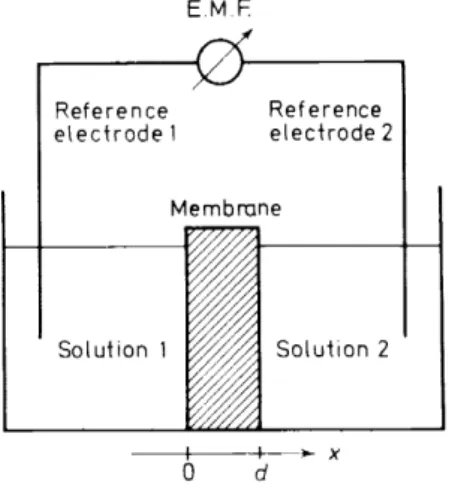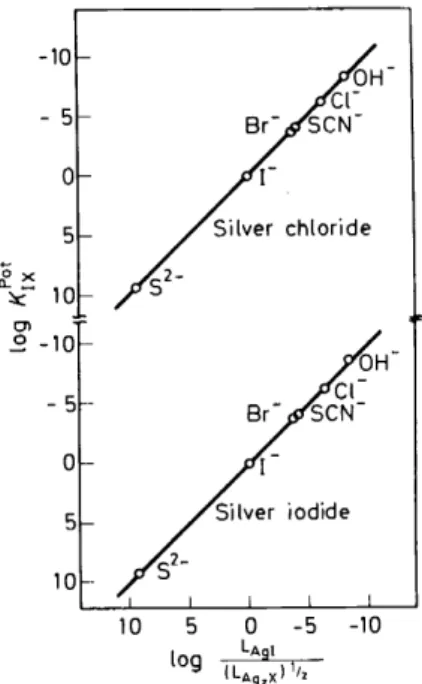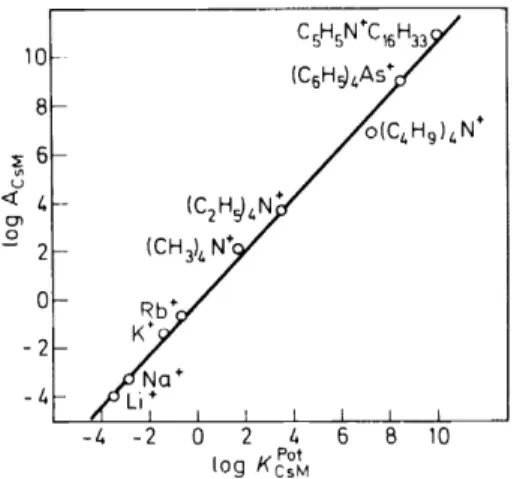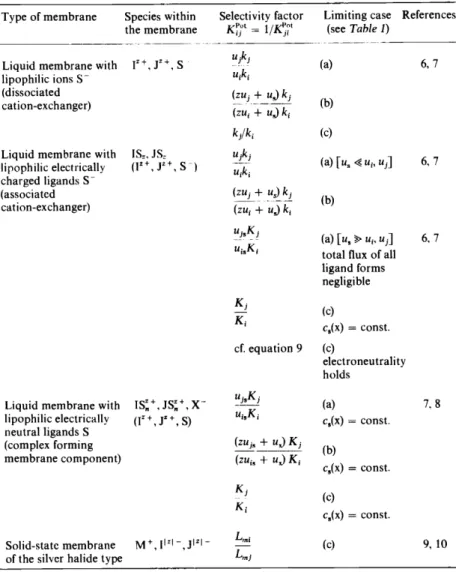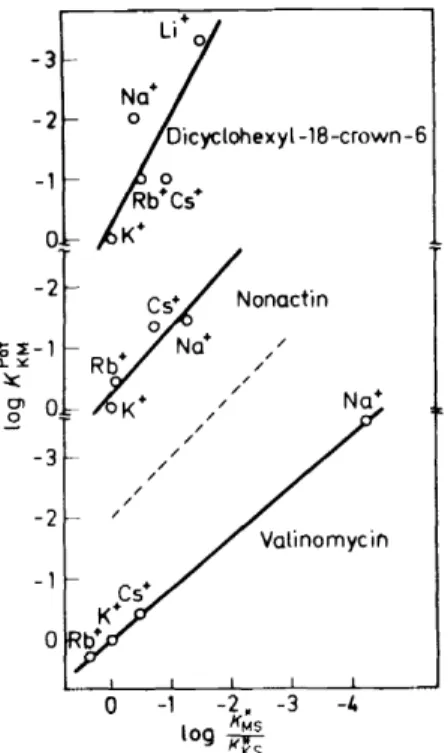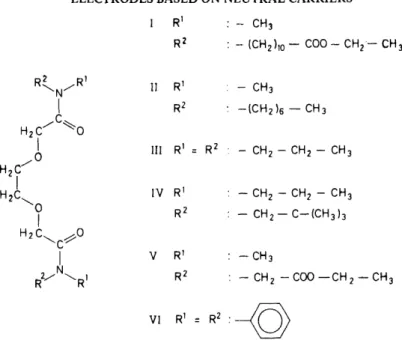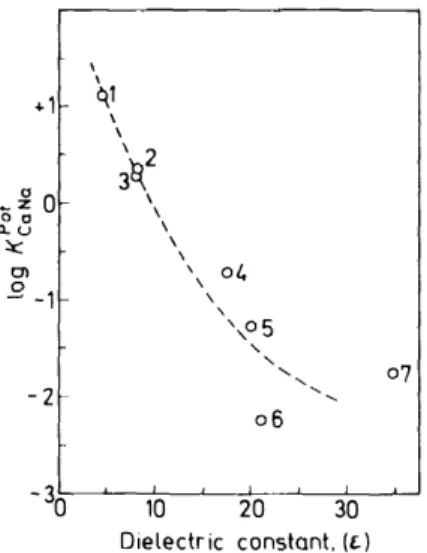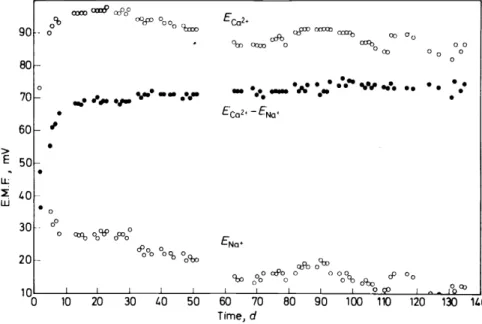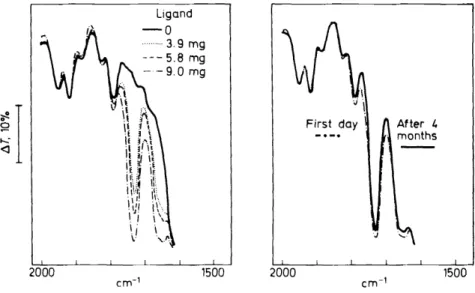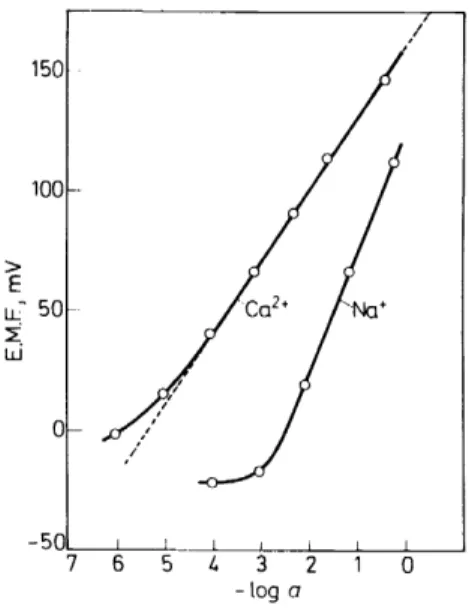CARRIER ANTIBIOTICS AND MODEL COMPOUNDS AS COMPONENTS OF SELECTIVE ION-SENSITIVE
ELECTRODES
W. E. MoRF, D. AMMANN, E. PRIITSCH and W. SIMON
Laboratorium für Organische Chemie, Eidgenössische Technische Hochschule, Zürich, Switzerland
ABSTRACT
The ion selectivity exhibited by different types of mem brane electrodes is rationalized by a theoretical treatment ofthe membrane potential. An equation, which is admirably suited for the interpolation of e.m.f.-values, is derived for the electrode response of membrane electrodes of the electrically neutral ligand type (antibiotics, model compounds) to mixed solutions of monovalent and divalent cations. In contrast to the classical Nicolsky equation it describes the contribution of interfering ions to the e.m.f. by an activity-independent selectivity term.
Electrically neutral ligands selective for calcium ions to be used as com- ponents for liquid membrane electrodes were de.signed and prepared. The corresponding electrodes are in all respects superior to the calcium ion liquid
membrane electrodes described so far.
In the past decade, a great nurober of selective ion-sensitive electrodes have been designed and have found application in all branches of routine analy- sis1-4. Usually, a membrane electrode assembly (shown schematically in Figure 1) is employed. The e.m.f. of this electrochemical cell is related to the ion activities in the sample solution by the extended Nicolsky equation
E
=
Eo+
RFT In Iai+
l: Kft(ay~tz
JJ
(1)zi
l
j*
iE: cell potential (e.m.f.) E0 : constant reference potential
ai: activity of a primary ion lz1 in the sample solution a.: activity of an interfering ion Jz J in the sample solution Kfjo{: selectivity factor, characteristic of a given membrane RT/F: Nernst factor
The theoretlcal treatment of the membrane potentialt has led to an under- standing of the ion specificity exhibited by different electrode types, the
t The so·called membrane potential is defined as the electrical potential difference between the two outside solutions (Figure 1) and may be broken down into a boundary potential and a diffusion potential, i.e. interna\ membrane potential. F or all practical purposes, the membrane potential can be regarded as the only activity-dependent contribution to the cell potential.
421
W. E. MORF, D. AMMANN, E. PRETSCH AND W. SJMON E.M.F
Reference electrode 1
Reference electrode 2
Membrane
Solution 1 Solution 2
0 d
Figure 1. Schematic representation of a membrane electrode assembly. In practical applications only the composition of solution l (aqueous sample solution) is varied. The half-cell comprising membrane, solution 2 (internal filling solution), and reference electrode 2 (internal reference
electrode) remains unchanged and constitutes the membrane electrode.
derivable selectivity factors
Kft
being in perfect agreement with experimental data5-9. Using the model assumptions given in Table 1 and evaluating the
Table 1. Model assumptions necessary to derive expressions corresponding to equation 15 The same solvent is used for the electrolyte solutions on either side of the membrane.
n A thermodynamic equilibrium exists between the membrane and each of the outside solu- tions at the respective phase boundaries.
iii Every cell component is homogeneaus with respect to a direction perpendicular to the cell axis; therefore, concentration gradients and the concomitant potential differences are possible only along this cell axis (x-coordinate, Figure 1). There is no pressure gradient.
tv The membrane phase approximates ideal behaviour, i.e. the activity of any component is equal to its concentration.
v Within the membrane, the chemical standard potentials and the mobilities of all particles present areinvariant with space and time.
vi The system is in a zero current steady-state.
vii There is no convection current across the membrane.
Assumptions i to vii are invoked simultaneously; in addition, one of the assumptions (a) to (c) holds:
(a) Within the membrane, the individual mobilities and/or concentrations of either all anions or all cations are negligible. All the particles whose fluxes give rise to a diffusion potential are of the same charge z.
(b) Throughout the membrane, the concentration gradients are negligible for all ionic species not of charge z. The electroneutrality condition holds.
(c) Within the membrane, the concentration gradients and/or the mobilities are negligible for all ions, i.e. the diffusion potential is nearly zero. Furthermore, the total concentration of all forms of cations respectively anions is constant.
422
e.m.f.-response to a primary ion and an interfering species of the same eh arge z according to
_ RT l [ Pot
J
E - E0
+
zF n ai+
Kii ai (la) the expressions for KLot compiled in Table 2 are obtained.As can be gathered from Table 2, theory predicts for a solid-state electrode with, for example, a silver halide type of membrane a correlation between the selectivity factors and the solubility products. Figure 2 (see also References
Figure 2. Cerrelation between the selectivity factors and the solubility products for silver halide solid-state membrane electrodes12.
1-4, 10--12) confirms that the solubility equilibria are, indeed, responsible for the ion-selective behaviour of solid-state membrane electrodes.
F or a liquid membrane composed of a water-immiscible solvent of suf- ficiently high dielectric constant, lipophilic anions S-, and counterions as strongly dissociated solute species, the electrochemical selectivity between cations of the same eh arge is given by (Table 2)
Kft ~ t.
I=
Aii(2) 423
W. E. MORF, D. AMMANN, E. PRETSCH AND W. SIMON
The ratio ofthe partition coefficients, Aii• represents the exchange equilibrium constant for the reaction
Iz + (membrane)
+
Jz + (solution) ~ Y + (membrane)+
Iz + (solution) (3) and is, therefore, independent of the chemical properties of any membrane components other than the solvent. It is known that a great number of organic solvents exhibit a selectivity for large ions. Thus, a useful sensor for large organic onium-ions has been designed using 2-nitro-p-cymene as selective membrane solvent and tetraphenylborate as cation-exchange sites 13. Figure 3, according to equation 2 ,shows a satisfactory agreement of(C2H~4N+
(CH3) 4 N+
Na+
- 4 Li+
CsHsN+C,6H33 (C6H~4As+
-4 -2 0 2 4 6 8 10 log K~~~
Figure 3. Correlation between the selectivity factors and the ion-exchange equilibrium constants for a liquid membrane electrode based on the solvent 2-nitro-p-cymene 1 J.
the selectivity factors Kft of this sensor with the exchange constants Aii, as obtained from salt extraction data 13. A similar correlation between selectivitv factors and extraction parameters is also to be expected for associated ion exchangers if the association between counterion and ion-exchange site has little influence on the ion selectivity of the system, i.e. the lipophilic exchanger ion exhibits no efficient ion specificity. Such a behaviour has been reported for anion-sensitive electrodes14-16 which are based on a membrane of decanol containing tetraalkylammonium ions as anion- exchange sites.
A more complex behaviour is to be expected for liquid membrane elec- trodes incorporating negatively charged ligands S- capable of selective complexation of cations. As is shown in Table 2 for this type of membrane, two completely different expressions for the selectivity between corres- ponding ions can be derived ,depending on which assumptions are made
K~?t 1 ~ _! k.
I) kj (4)
424
Table 2. Expressions for the selectivity between a primary ion 1= and an interfering ion F for different types of membrane electrodes5.
Type of membrane Species within Selectivity factor Limiting case References the membrane Kft = 1/ K!;~' (see Table 1)
- - - - ~-~---
Liquid membrane with JZ+, y+, s uiki
(a) 6, 7
lipophilic ions S- uiki
(dissociated ~ui::+" uJ ki
cation-exchanger)
(zui + uJ ki (b)
kJik; (c)
Liquidmembrane with ISz, JS= uiki
(a) [ u, ~ ui, ui] 6, 7 lipophilic electrically w+, JZ+, s -)
U;k;
charged ligands S-
(associated (zui -f-_us2_~
cation-exchanger) (zui + uJ k; (b)
ui.Ki
(a) [u. ~ u;, ui] 6, 7 u;.K;
total flux of all Iigand forms negligible
Ki (c)
K; C8(X) = const.
cf. equation 9 (c)
electroneu trali ty holds
Liquid membrane with Is~+,Js!+,x- ui.Ki
(a) lipophilic electrically (Iz +' J" +' S) U;8K;
C8(X) = const.
neutralligands S
(zui• + uJ Ki
(complex forming - - - - (b)
membrane component) (zu;.+ uJK;
c.(x) = const.
Ki (c)
K; c.(x) = const.
Solid-state membrane M+,flzi-,JIZI- Lrni (c)
of the silvcr halidetype L,nj
k: partition coefficients of cations between outside solution and membrane
K: partition coefficients of cations between outside solution and the respective complexes in the membrane 1~,.1, L,.1: solubility products of the pure silver halides
u: mobilities in the membrane c(x): concentrations in the membrane z: ionic eh arge
and
7, 8
9, 10
(5) Whereas the first expression again represents the selectivity as a function of the membrane solvent alone, the second relation, on the other band, de-
425
W. E. MORF, D. AMMANN, E. PRETSCH AND W. SIMON
scribes the ion-selective behaviour of the Iigand. Thus, the ratio Ki/K; is equal to the equilibrium constant for the ion-exchange reaction
ISz (membrane)
+
Jz + (solution) ~ JSz (membrane)+
Iz + (solution) (6) It follows:(7) where K;s and K is are the stability constants of the respective complexes in the membrane. K~ and Kjs are the membrane-independent complex
stability constants in the outside solution.
In practice, however, neither of the limiting cases as defined by equations 4 and 5 is realistic (cf. stipulations in Table 2). A rather reasonable approach is to formulate the electrode response as follows
R T [ Pot 1
J
R T [ Pot 2J
E = E0
+ (;-+t)F
In ai+
Kii ai+
z(z+
l)F ln a;+
Kii ai (8) This equation can be derived from theory when the diffusion potential is assumed to be negligible (cf. assumption (c) in Table 1) and the electroneu- trality condition is validt. Starting from equation 8, the usual selectivity factor defined by the Nicolsky equation (la) is found tobe(
a.
){z/(z
+ Ill ( a.) i 1/(z+ n: a.K~ot =
Kft
1+
~Kft
2+ ---'- -
~ai ai ai
(9)
With this it is proved that the electrochemical selectivity between cations of the same charge displayed by liquid membranes with charged ligands is a function of the activities in the sample solution. Furthermore, it is evident that a sufficiently high discrimination of interfering ions can be achieved only if both membrane components, solvent and Iigand, exhibit a comparable ion specificity. Thus, for example, liquid membranes consisting of a solution of the potassium-selective carrier antibiotic nigericint (ratio of the complex stability constants K:s/K~as ~ 5017) or the sodium-selective antibiotic monensin:l: (K~as!K:s ~ 2517) in decanol (ANaK ~ 2) are not suited for the preparation of sensors for the respective ions. In agreement with experimental results 1 Y, the selectivity of these systems come out to be rather poor:
nigericin in decanol: K~~a "' 0.1 - 0.25 ~nd monensin in decanol: K~~·K "' 0.3 - 1.
As a consequence of the expected activity dependence of the selectivity factors, especially for liquid ion-exchange membranes, the unqualified use of the Nicolsky equation in assessing the electrode response to mixed elec- trolyte solutions can be misleading. A serious difficulty arises if the electrode
- - - · - - -
t For monovalent ions, a more general description is available owing to the theoretica] work of Sandblom, Eisenman and Walker6.
! The carrier antibiotics of the so-called nigericin group have a dissociated carboxylate group at physiological pH and, therefore, form electrica11y neutral 1 :1 complexes with alkali meta! ions17· tR.
426
potential is produced by a mixture of ions of different charge; for instance, for a divalent cation 12+ and a monovalent cation J+, both of which are in equilibrium with the respective lipid-soluble complexes IS2 and JS at the membrane surface, the fundamental equation is
IS2 (membrane)
+
2J+ (solution) ~ 2JS (membrane)+
12+ (solution) (10) Since the differentiation between a primary ion and an interfering ion is arbitrary in this case, two inconsistent expressions of the Nicolsky type (1) are admissible:E = E 0
+ --
R T 2F 1 n a.l
I+ . .
KPot I} a. J2]
(lb) and(lc) It is obvious that the weighting factors
Kft
andKrtt.
both characteristic of the ion selectivity, must again be to a large degree activity-dependent. A detailed theoretical study of the monovalent-divalent ion selectivity demon- strates that the response ofliquid membrane electrodes incorporating charged ligands can generallynot be reproduced by any explicit expression containing only sample solution-activities and constant selectivity parameters. It can be shown, however, that equation 1 b constitutes a reasonable approximation for liquid membrane electrodes highly responsive to monovalent cations, whereas equation 1c more successfully delineates the behaviour of liquid :qtembrane electrodes highly sensitive to divalent cations20. In practice, the alternative representation is commonly preferred; hence one has to cope with large variations in the selectivity factors.In striking contrast to liquid membrane electrodes with negatively charged complexing agents, the behaviour of membranes based upon electrically neutralligands S is fully resolved by theory. As can be gathered from Table 2, the selectivity of neutralligand electrodes between cations of the same eh arge is for every limiting case listed determined as
K~?t ~ K. _1
I} Kj (11)
Again, the ratio K /Ki is identical to the equilibrium constant for the exchange reaction:
IS~ + (membrane)
+
Jz + (solution) ~ JS~ + (membrane)and is found to be :
Ki Kis ki K!s kis Ki = Kis ki
=
K:kis+
Iz+ (solution) (12)(13) where Kis• K is and K:, Kjs are the complex stability constants in the mem- brane and in the outside solution respectively, and kis• kis are the partition
427
W. E. MORF, D. AMMANN, E. PRETSCH AND W. SIMON
coefficients of the positively charged complexes between the outside solution and the membrane. Equation 13 suggests that extremely high selectivities can be achieved by using neutral ion-specific ligands as membrane compo- nents. Suitable lipophilic ligands have been available since the discovery of highly selective carrier antibiotics, such as valinomycin or the macrotetro- lidest, and of related synthetic ligands, for example crown compounds. (For a review see Reference 18).
In the case of carrier antibiotics that are capable of enveloping monovalent cations completely and evenly18, the complex mobilities and partition coefficients are entirely independent ofthe nature ofthe centrat ion. According to Table 2 and equation 13, the alkali ion selectivity of the respective liquid membranes is then determined solely by the complexing properties of the carrier ligands5• 7
' 8
(14) Figure 4 demonstrates impressively that e.m.f.-measurements are a welcome
L.+ I Q
-3
_,
-:t c
+ Nonactin"E
~-
1 + o s Na• /a..~~ Rb //
/
~ 0 K+ //
-
/ /-3 //
/ / /
-2 /
Valinomycin
-,
0
0 _, -~. -3 -4 log~
KKS
Figure 4. Con elation between the selectivity factors and the complex stability constants for liquid membrane electrodes basedonneutral carrier ligands5 (see also references 21, 22).
t In contrast to the carrier antibiotics of the nigericin group, the representatives of the valinomycin group behave as electrically neutralligands.
428
method for directly assessing the relative stabilities of the complexes of the valinomycin group antibiotics in the outside solution, i.e. in water and water- like solvents. The selectivity factors of the liquid membranes are in this case independent of the membrane solvent used 21.
If, however, the ligands used as membrane components are not able to completely displace the solvent shell of the cation, as is the case with many of the synthetic crown compounds, equation 14 is not valid, since now the membranesolvent has a remarkable influence23 on the ion-exchange reaction, equation 12. The rather poor correlation between the· selectivity factors and the ratios of complex formation constants found for crown compounds (see Figure 4 and Reference 22) is therefore not surprising.
As is demonstrated above, it is possible to successfully rationalize the selectivity of membrane electrodes between ions of the same charge if the diffusion potential, i.e. the internal membrane potential, is assumed to be negligible (see Table 2). Under such conditions, a theoretical treatment of the monovalent--divalent ion selectivity of liquid membrane electrodes based on neutralligands can be carried out24• In analogy to equation 10, the following ion-exchange equilibrium is assumed to determine the electrode response
IS~ + (membrane)
+
2J + (solution) ~ 2JS + (membrane)+
I 2 + (solution) (15)It is helpful to define the equilibrium constant for reaction 15 as KM= aixi 2
'J af xi (16)
where x signifies the fraction of the complexed Iigand concentration at the membrane surface, ctot, that is coordinated to one cation species. The constant K~ is related to the complex stability constants and partition coefficients as follows
K*2 k2
M js js
Kii
=
2K' k. ctotIS IS
(17) As presented elsewhere24, an appropriate expression for the electrode response to a mixed solution of I2+ and J+ can be derived
E
=
E0+
RFT In [(ai+ i K~
ay)!+ (-.i K~
af)!] (18)The superiority of this formulation over either of the commonly employed Nicolsky equations 1 band lc will be impressively substantiated below.
As shown in the previous treatment, the electrically neutral antibiotics of the valinomycin group25 and related lipid-soluble ligands are predestined to be incorporated as the active components in highly selective liquid mem- brane electrodes because the remarkable specificity they exhibit in their complexation behaviour towards cations can be fully exploited in this manner. The analytical potential of these ion-selective sensors has been recognized and forms incorporating electrically neutral ligands specific for
429
W. E. MORF, D. AMMANN, E. PRETSCH AND W. SIMON
K +, NHt, Ba 2 + and Ca 2 + have found acceptance in practical applications18· 26
.
At present the roster of suitable carrier molecules is limited to a small nurober of natural and synthetic compounds. The results of the model calculations described earlier27 establish a framework ofmost likely desirable characteristics, from which the synthesis of new neutralligands can proceed.
According to these calculations the requirements governing the suitability of electrically neutralligands as carriers for alkali or alkaline-earth metal ions including ammonium ions in membranes are2 7
(a) A carrier molecule should be composed of polar and nonpolar groups.
(b) Among the polar groups there should be preferably 5 to 8, but not more than 12 coordinating sites such as oxygen atoms.
(c) Ideally, all cations should be forced into accepting the same given nurober of coordinating groups.
(d) The carrier should be able to assume a stable conformation that provides a cavity, surrounded by the polar groups, suitable for the uptake of cations, while the nonpolar groups form a lipophilic shell around the coordination sphere.
(e) High selectivities are achieved by locking the coordinating sites into a rigid arrangement around the cavity. Such rigidity can be enhanced by the presence of bridged structures or hydrogen bonds. Within one group of the periodic system, the cation that best fits into the offered cavity is preferred.
(f) Notwithstanding requirement (e), the Iigand should be flexible enough to allow a sufficiently fast exchange. This is possible only with a stepwise substitution of the solvent molecules by the Iigand groups. Thus, a compromise between stability (e) and exchangerate (f) has to be found.
(g) The overall dimensions of a carrier should be rather small but consistent with high Iipid solubility.
(h) Electrically neutral Li+- or Na+ -specific carriers should contain no more than 6 coordination sites.
(i) Electrically neutral ligands designed to be specific for large alkaline- earth cations must be assmallas possible and should be used in mem- brane solvents of high dielectric constant. A neutral carrier specific for Mg2 + seems unlikely.
Ligands were designed28• 29 which, in accordance with the model set forth above, should exhibit a preference for divalent cations (see Figure 5).
The Iigand most thoroughly studied, and the first of this series to be syn- thesized, contains six potential coordination centres, namely two etheric oxygens as weil as the carbonyl oxygens of two amide and two ester groups (Iigand I). F our of these coordination sites are separated by three segments of two atoms each, thereby predetermining five-ring chelates (optimal size of chelate rings30). The high flexibility provided by the acyclic structure ensures a step-wise substitution of the solvate shell of the cation by Iigand coordination groups. Thus, the rapid complexation and decomplexation necessary for the incorporation in sensors is given31. The coordination sites are interconnected by an aliphatic skeleton. lt is intended that the small ligand-layer thickness achieved herewith shalllead to a preference of divalent
430
Rl : - CH3
R2 : - (CH 2)10 - COO- CH2·-CH 3 R2 Rl
' N / li Rl - CH3
I
R2 -(CH2 ls-CH3H c/ c ~o
21 111 Rl R2 - CH 2 - CH 2 - CH 3 H
c/
021
IV Rl - CH 2 - CH2 - CH 3 H2C..._
0 R2 - CH2- C-(CH3l3
I H2C..._ ~0
c
I
V Rl - CH32 N
R/' ' R1 R2 - CH 2 - COO -CH 2 - CH 3
VI Rl R2
·-{J>
Figure 5. Structures of some synthetic carriers specific for alkaline-earth metal ions.
over monovalent cations. Compound I, in fact, does show28 · 32 a high Ca2+- selectivity (Table 3). The properlies of this calcium sensor are discussed below.
Providing that there is a large excess of calcium ions a 1 :1 complex exists in methanol. More recent investigations employing 13C-n.m.r.-spectro- scopy33 indicate that the esteric carbonyl groups do not participate as Co- ordination sites. If the Ca 2 + -induced chemical shifts are plotted against the Ca2+ :Iigand concentration ratio, the resonance frequencies of a nurober of carbon atoms are shifted by amounts that attain a maximum and a minimum
Table 3. Electrochemical selectivity behaviour of the synthetic ligands I-VI presented in Figure 5. The e.m.f.-responses of the respective sensors (PVC matrix) to 10-12 M solutions of
different cations are given (referred to Ca2+).
Cation EM-ECa• mV
Mz+ for Iigand
II III IV V VI
---~~--~-
Mgz+ -110 -112 -101 -111 -95 -81
Ca2+ 0 0 0 0 0 0
ßa2+ -1 -3 -40 -50 -65 +73
Na+ -73 -77 -91 -103 -92 +13
K+ -82 -86 -82 -75 -66 +3
es+ -103 -109 -103 -107 -89 -34
431
W. E. MORF, D. AMMANN, E. PRETSCH AND W. SIMON
respectively for a concentration ratio of about 0.5. Accordingly, the stoichio- metry of the complexes should be different for small (probably 1 :2) and for large metal concentrations (1 :1, four coordination sites occupied by the Iigand, all others by methanol).
Ligand li does not contain the terminal ester groups. Since this Iigand behaves quite similarly to Iigand I in sensor systems (see Table 3), these ester functions surely do not contribute to the high Ca 2 + -selectivity. Both ligands probably form 1 :2 complexes with Ca2 + in the sensor. Investigations carried out with compounds III and IV (cf Table 3) indicate that the N -alkyl groups are of minor importance as concerns the selectivity behaviour of the ligands.
The similarity in ion-selective behaviour of ligands I-IV and Iigand V ( Table 3) gives rise to the assumption that it is the same coordination sites in V as in I-IV that are actively involved in complexation. lt is, indeed, deducible from 1 3C-n.m.r.-spectra that the esteric carbonyl groups do not participate in complexation33.
The substitution of the N-alkyl groups by N-phenyl groups (Iigand VI) Ieads to a preference for }arger ions (Ba2+ > Ca2+, cf. Table 3). This can be rationalized by assuming that the steric interactions among the phenyl groups result in a larger cavity between the coordination sites. The intro- duction of phenyl groups also degrades the discrimination of monovalent cations. A possible explanation is the marked swelling of the Iigand layer.
On the other hand, it should be kept in mind, that a decrease of the electron density at the carbonyl oxygens invariably produces the same effect.
Recently, andin accordance with the concepts set forth above, a crystalline
+1
~~ 0
0 c
a..u
~ C1l
E -1
-2
I
~1
\
\
\ 2
J'r\
\
\
\
\
\
\ ot.
\
' ',05 ' ' ...
o6
Oielectr ic constant. (L.) o7
Figure 6. Selectivity for Na+ relative to Ca2 + of a liquid membrane electrode (filter paper matrix) based on Iigand I as a function of the dielectric constant of the membrane solvent. Membrane solven.ts: (1) ~ihutylsebacat~, (2) tris-(2-ethylhexy~)-phosphate, (3) 1-dec~n.ol, (4) aceto~henone, (5) 2-mtro-p-cvmene. (6) p-mtroethylhenzene. (1) mtrohenzene. The selectlvlty factors Kc~'Na were obtained from e.m.f.-measurements using l0-1 M calcium chloride and 10-1M sodium chloride
respectively as sample solutions.
432
Ba2 + -complex of this Iigand was obtained that an eiemental analysis showed tobe of 1 :2 stoichiometry.
In the course of the development of a useful alkaline-earth ion specific sensor based on electrically neutralligands, such as those presented above, particular attention is to be paid to the selection of a suitable water- immiscible membrane solvent. As has been realized only recently32, the dielectric constant of the chosen membrane solvent is not a matter to be casually overlooked. Theoretical sturlies indicate that the higher it is, the better should monovalent cations be discriminated by the neutral ligands incorporated in the sensor. This prediction is handily confirmed by experi- mental evidence presented in Figure 6. Furthermore, the lifetime and the stability of sensor systems can be greatly modified through variation of the membrane matrix 1.
An electrode incorporating the calcium-selective Iigand I has been developed34 that is superior to a previously described electrode32 in terms of lifetime and stability, mainly because of the PVC-matrix 1 employed. The membrane is prepared from a solution of 3 per cent Iigand I and 30 per cent PVC in 67 per cent o-nitrophenyl octyl ether. The lifetime oftbis sensor comes to more than a half year while the potentials drift at a rate of 0.1 m V d-1. The final membrane bad a thickness of about 0.5 mm and was mounted in a Philips electrode body type IS 560. Membranes of this type must be condi- tioned for 5 to 10 days (Figure 7), whereas sensors incorporating either
0000 cxn9 a:Po0
Eea2·
0% oOcfP 00 00 'h=
90 . 0 a:fb o:fiD = =b QJ 00
%> Q:o:) 0 co::~b QJ 0 0
0 0 0
80t-
0
... --
.". • .,. ... w .... ••• • • • •
70-
-· .. ,. .,. . - ... . .
Eca2• -ENa'
60
,
>
•
E 50
LL.:
:i L.O r-
u.i
30 00 0 q;q,
oo9::9 ooooo
ENa•
cf'o o
20~ o o oq, o
0C:OO
ClfooG::o 't:c 0o c&o o
o ooo% o'bo cP 00
0o o
10 I Or::f) I~Q:>
0 10 20 30 L.O 50 60 70 80 90 100 110 120 130 140
Time, d
Figure 7. Response of the PVC electrode incorporating Iigand I as a function of time. The e.m.f.- values were measured using unbuffered 10-2 M solutions of the metal chlorides at roum
temperature.
433
W. E. MORF, D. AMMANN, E. PRETSCH AND W. SIMON
thinner membranes of similar composition or membranes saturated in respect to calcium chloride can be used immediately without impairing the selectivity, the stability, or the lifetime. Using i.r.-spectroscopy, it has been shown that the Iigand resides in these membranes in practically undiminished concentration for periods of over 100 days (Figure 8).
~r
...
<l
2000
Ligand
-o
... 3.9 mg ---5.8 mg --9.0 mg
1500
\
First day
2000 1500
Figure 8. Infrared spectra of PVC membranes incorporating Iigand I. The ester carbonyl absorption band of thc Iigand was used for reference purposes. The plot on the left shows the dependence on Iigand concentration in the membrane, while the other graph compares the spectrum of an unused membrane with the spectrum of the same membrane after 4 months of
continuous use in a sensor.
The e.m.f.-response of this sensor to sample solutions containing calcium chloride and sodium chloride respectively is represented in Figure 9. As activity standards the fundamental values set forth by Bates35 were employed;
the activity coefficients Yca were found tobe related to the ionic strength I as log Yca = - 2.04/!(1
+
1.55/t)-1+
0.2/ (19) lt is evident from Figure 9 that the described electrode exhibits a perfectly Nernstian response over a 10°--. to-5 M calcium range, as weil as a linear response tosodiumdown to about 5 X 1o-
3 M (see Table 4). Deviations from a purely Nernstian response are most likely explained by local deviations from the bulk equilibrium that is assumed to exist between the surface of the membrane and the bulk of the sample solution, especially so in the proximity ofthe phase interface. In Table 5, the selectivity factors K~~·M for a considerable nurober of cations Mz + are compiled. Each of these values was calculated434
/ 150
100-
>
E
lL 50
~ t.J
/
I
0 /
-50
7 6 5 I. 3 2 0
-log a
Figure 9. E.M.F.-response of the sensor using Iigand I in PVC to unbuffered aqueous solutions of calcium chloride and sodium chloride respectively (25°C). Philips elcctrode body JS 560.
Table 4. Calculated slopes of the e.m.f.-response in Figure 9 at 25''C.
Electrode response to calcium Electrode response to sodium
---~-~ ~ ~----
Concentration range Slope in m V flog Oca Concentration range Slope in m V flog aNa
10°-W 5 M
wo
-to-4 Mto-t 10 4M Theoretical
(linear regression) 28.6 29.2 29.6 29.6
wo
w-3 M10°-10-2 M Theoretical
(linear regression) 45.8 49.4 59.2
Tahle 5. Selectivitv factors K~~\., characteristic of the described sensor based on Iigand I (from e.m.f.-measurements using 10-2M metal chloride solutions).
Mz+ K~~k Mz+ KPot
CaM Mz+ KPot
CaM
- - - · - - - - - - - - - -
Mg2t 2 X w-4 Li+ 6 X
w-2
NHt 1 X w-12 X w- 4t
Ca2+ 1 Na+ 3 X w-1 AJ3+ 2 X w-4
1 x w-1t
Sr2+ x
w- 1
K+ X w-t Cu2+ 2 X w-3 4 X w- 2tBan 9 X
w-1
Rb+ 3 xw- 2
Zn2+ 6 X w-4es+ x
w- 2
Ce3+ 2 Xw-2
t From e.m.f.-measurements using 10 1 M solutions.
435
W. E. MORF, D. AMMANN. E. PRETSCH AND W. SIMON
from the electrode response to a
to-
2M solution of the respective chloride salt by applying a simplified form of Nicolsky equation 1E = E o
+
R TIn[KPot
a2tzl
2F CaM M _ (ld)
The discrimination of potassium and sodium ions by the sensor incorpora- ting Iigand It is somewhat reduced as compared to a PVC-electrode con- taining the Orion liquid ion-exchanger 92-20-02 (Figure 10). One of the
~I
>
E
lL~
~ u.i
6
Neutral Iigand I in PVC
5 4 3
- log o
2 6
Orion ion exchanger in PVC
5 4 3
-log o 2
Figure 10. Comparison of the iesponse of PVC electrodes with Iigand I respectively classical ion exchanger to different cations in non-buffered aqueous solutions (25°C). Philips electrode
body IS 560.
improvements34 over the PVC-sensor using the Orion exchanger, and even more so the Orion 92-20 electrode, consists in the minimized hydrogen ion sensitivity. This low pH -interference was achieved through the use of neutral ligands devoid of any functional groups that could enter acid--base reactions.
A further noteworthy trait of the calcium-sensor described here is its selec- tivity among divalent cations; for example, the marked discrimination of magnesium or zinc ions observed is unprecedented.
t 1t is evident from Table 3 that Iigand IV, for example, exhibits a considerably higher specificity for calcium ions.
436
A potentially important application of calcium-sensors is the determina- tion of the ionic calcium Ievel in human blood serum. Since in this liquid the sodium concentration (- 0.15M) is about two orders of magnitude greater than the calcium Ievel to be measured, a grave interference of the form er ion with the response to the latter would be expected. Deviations from the perfect calcium-response accruing from the presence of large amounts of sodium are of little importance, however, as is shown by e.m.f.-measurements conducted on mixed solutions of calcium chloride and sodium chloride. lt would be unwise, though, to interpret this as incontrovertible evidence for a Iack of sodium-interference, i.e. that the selectivity factors K~~~ representative for mixed solutions are very small. Rather, it seems as if the interfering ion 's direct influence on the electrode potential is very nearly compensated by the induced change in the activity coefficient of calcium. If the sensor is to be judiciously employed to determine the Ca2 + -concentration in a sample such as blood serum, it is imperative that the electrode be calibrated against solutions of similar composition.
For sensors of the type propounded here, the expression 18 derived from theory is admirably suited for the interpolation of e.m.f.-values for samples resembling the electrolyte composition of blood serum (Yca ~ 0.33, from 19). In principle, two calibration measurements are all that is needed. The e.m.f.-response towards a solution of pure calcium chloride of a given activity will serve to fix a value for E0 , and from the response, in the absence of cal-
110
> 100 f lL 2 w 90
80
I I
I
E lectrolyte composition
Ca Cl2 I I I
/I
0.150 M Na Cl 0.005 M KCl 0.001 M Mg Cl2
I I / I / I
I I / I
I I
/ I / I / I / I
I I
/ I / I
/ I
/ I
/ I
.,/ I
_,/ /
_
_", /---
5 4 3
-log Cca
2
Figure 11. Comparison between calculated and measured response to Ca2+ ofthe PVC electrode using Iigand I (25oq; Na+-, K +- and Mg2+ -level comparable to blood serum.
Upper curve: eqtrat~on lc} Kf?1 respectively K~<A assumed tobe constant lower curve : equatlon 1 b 1 1
solid line: equation 18
437
W. E. MORF, D. AMMANN, E. PRETSCH AND W. SIMON
>
E lL
z:
L!J
J
Neutrat Iigand I
//~
in PVC ~ V"«>
e•/
-~.,....
1/J
C) C) ·~
e
j/J
I1/'--
Orion ion~~~ exchanger
_ / : ; ' in PVC
o---e
~Neutral Ligand IV
• in PVC
5 3
-log Cca
2
Figure 12. Response of different electrodes to Ca2 + in an electrolyte comparable to blood serum (NaO O.l50M, KCI 0.005M, MgCJl O.OOlM), 25"C; Philips electrode body IS 560.
solid lines: calculated response according to equation 18.
dotted line: calculated response according to equation l b assuming Krt to be constant.
cium, towards the presumably constant background of interfering ions it is possible to calculate the interfering-ion term K~aNaa~a in equation 18. The electrode potentials calculated according to equation 18 and those measured were found to coincide to a remarkable degree (Figure 1 1). In the range10-4 M
to 10-1 M Ca2 + the average deviation turns out to be of the order of only 0.5 mV. The same Ievel of precision was attained with interfering-ion back- grounds of 0.1 M and even 1 M sodium chloride.
The Iigand IV prepared recently shows a discrimination of sodium in PVC-sensors which is at least ten times )arger than the one obtained using compound I (Table 3). Figure 12 clearly demonstrates that the corresponding electrode is in all respects far superior to the ones prepared earlier. A clinical application, for example, is certainly within reach.
ACKNOWLEDGEMENT
The present work was partly supported by the Schweizerischer Nationalfonds zur Förderung der wissenschaftlichen Forschung.
REFERENCES
1 G. J. Moody and J. 0. R. Thomas. Selective lon-Sensitil'e Electrodes, Merrow, Watford (Herts.), 1971.
438
2 J. Koryta. Anal. Chim. Acta 61, 329 (1972).
3 R. F. Buck. Anal. Chem. 44, 270R (1972).
4 R. A. Durst (Ed.). lon-Selective Electrodes, National Bureau of Standards, Spec. Fubl. 314, Washington, 1969.
5 H.-R. Wuhrmann, W. E. Morf and W. Simon. Helv. Chim. Acta 56, 1011 (1973).
6 J. Sandblom, G. Eisenman and J. L. Walker. J. Phys. Chem. 71, 3862 (1967).
7 G. Eisenman. in Reference 4.
~ S. Ciani, G. Eisenman and G. Szabo. J. Membrane Bio[. 1, 1 (1969).
9 R. P. Buck. Anal Chem. 40, 1432 (1968).
10 E. Fungor and K. Toth. llung- Sei. Instruments 14, 15 (I 968); 18, 1 (1970).
11 1. W. Ross. in Reference 4.
12 G. Kahr. Dissertation ETH, Zürich, 1972; G. Kahr, W. E. Morfand W. Simon. In preparation.
u R. Scholer and W. Simon. Helv. Chim. Acta 55, 1801 (1972).
14 H. J. James, G. F. Carmack and H. Freiser. Anal. Chem. 44, 853 (1972).
15 C. J. Coetzee and H. Freiser. Anal. Chem. 41, 1128 (1969).
16 S. Bäck. Anal. Chem. 44, 1696 (1972).
17 W. K. Lutz, P. V. Früh and W. Simon. Ilelv. Chim. Acta 54,2767 (1971).
18 W. Simon, W. E. Morf and P. Ch. Meier. Structure and Bonding, Vol. 15, Springer Verlag, Heidelberg, 1973.
19 Orion Research Inc. Newsletter 2, 14 (1970).
20 J. Bagg, 0. Nieholsan and R. Vinen. J. Phys. Chem. 75, 2138 (1971); J. Bagg and R. Vinen.
Anal. Chem. 44, 1773 (1972).
21 E. Eyal and G. A. Rechnitz. Anal. Chem. 43, 1090 (1971).
22 G. A. Rechnitz and E. Eyal. Anal Chem. 44,370 (1972).
23 H. K. Frensdorff. J. Amer. Chem. Soc. 93,4684 (1971).
24 W. E. Morf, D. Ammann and W. Simon. In preparation.
25 Z. Stefanac and W. Simon. Chimia 20, 436 (1966); Microchem. J. 12, 125 (1967); W. Simon, Swiss Patent No. 479870 Nov. 28 1969.
26 W. Sirnon and W. E. Morf. In Jon-Selective Electrodes, E. Fungor (Ed.), Akademiai Kiadö, Budapest, 1973.
27 W. E. Morf and W. Simon. Helv. Chim. Acta 54, 2683 (1971); W. Sirnon and W. E. Morf.
In Membranes, Vol. 2, G. Eisenman (Ed.), M. Dekker, New York, 1973.
28 D. Ammann, E. Fretsch and W. Simon. Tetrahedron Letters 24, 2473 (1972).
29 D. Ammann, E. Pretsch and W. Simon. Helv. Chim.Acta. In preparation.
30 G. Schwarzenbach. H elv. Chim. Acta 35, 2344 (1952).
31 H. Diebler, M. Eigen, G. Ilgenfritz, G. Maass and R. Winkler. 11. I.C.C.C., Haifa, 1968;
Pure Appl. Chem. 20, 93 (1969).
32 D. Ammann, E. Pretsch and W. Simon. Anal. Letters 5, 843 (1972).
33 R. Büchi, D. Ammann, E. Fretsch and W. Simon. Helv. Chim. Acta. In preparation.
34 D. Ammann, W. E. Morf, E. Pretsch and W. Simon. Anal. Chim. Acta. In preparation.
35 R. G. Bates, in Reference 4.
439
